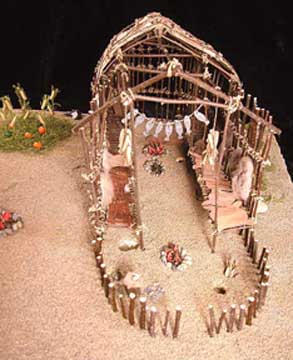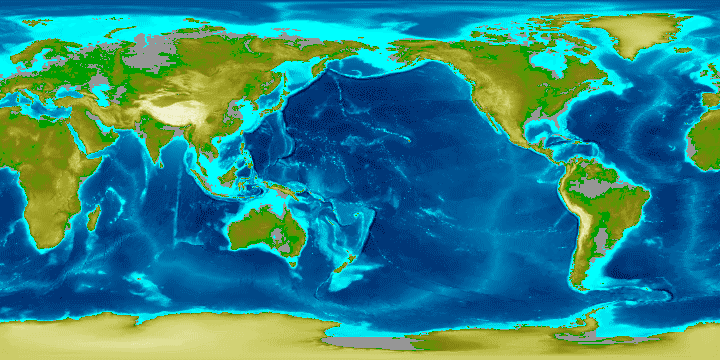
What
kinds of things did they eat?
The Huron were horticulturalists,
which means they were farmers or gardeners. They grew their own corn, beans,
and squash. In this longhouse you can see corn and some things that look like
pumpkins. Pumpkins are a type of squash. Why did they grow these three things
together? Corn, beans, and squash are called the Three Sisters. Corn and beans
have amino acids in them. Amino acids are what we need to make protein. We
usually get this from meat, but some people don't eat meat. Some people are
vegetarians. They need to find their protein from other foods. Corn and beans
have amino acids that complement each other. This means that if you eat them
together, you will get a complete protein. If you eat them separately you
will have an incomplete diet. The Huron were also hunters and gatherers. They
hunted animals like deer, bear, and wolves. They fished from the lakes and
rivers around their village. The Huron gathered berries and roots for food,
as well as other things that could be used for making different medicines.

Inuit ate only meat and fish. Lichens and moss were the only types of vegetation
that grew in the Arctic. The Inuit people did not want to eat the lichens
and moss right off the rocks. (Yuck! I don't think you would like to eat moss
either!) There was one way that the Inuit could get the nutrients that they
needed from vegetation and this might surprise you! Caribou like to eat moss
and lichens. When Inuit hunters killed a caribou, they opened up its stomach
to see if the caribou had eaten any lichens and moss. If some of this partially
digested vegetation was in the stomach, the Inuit would eat it to get the
nutrients they needed. This was a delicacy, which means that it was very special
and very desired.
The Haida and other Northwest Coast people did not need to grow their own
food. They had access to many different kinds of food. Because there was a
milder climate, many edible things, as well as things that they used for different
medicines grew in the forests around their villages. They were hunters and
gatherers. They hunted animals like deer, bear, and mountain goats in the
forests and mountains. The Haida also fished in the rivers and lakes. Most
impressive, they hunted large sea mammals like seals and sea lions.
Activity: Growing Corn
Corn, beans and
squash were domesticated in North America. What does domestication mean?
Domestication means
that humans have taken something wild and have tamed it. A long time ago,
when people started to populate North America, they had to search for things
that were good and safe to eat. When they found something that they liked
they would dry the seeds and plant them in them ground year after year. This
was what we call trial and error. If something worked, they would keep doing
it. If something did not work, they would not repeat it. So, things like corn
and wheat once looked like grass with very small seed heads.
What other plants
were domesticated in North America?


 ©
Pond Inlet 1953-54 (Prince of Wales Northern Heritage Center)
©
Pond Inlet 1953-54 (Prince of Wales Northern Heritage Center)